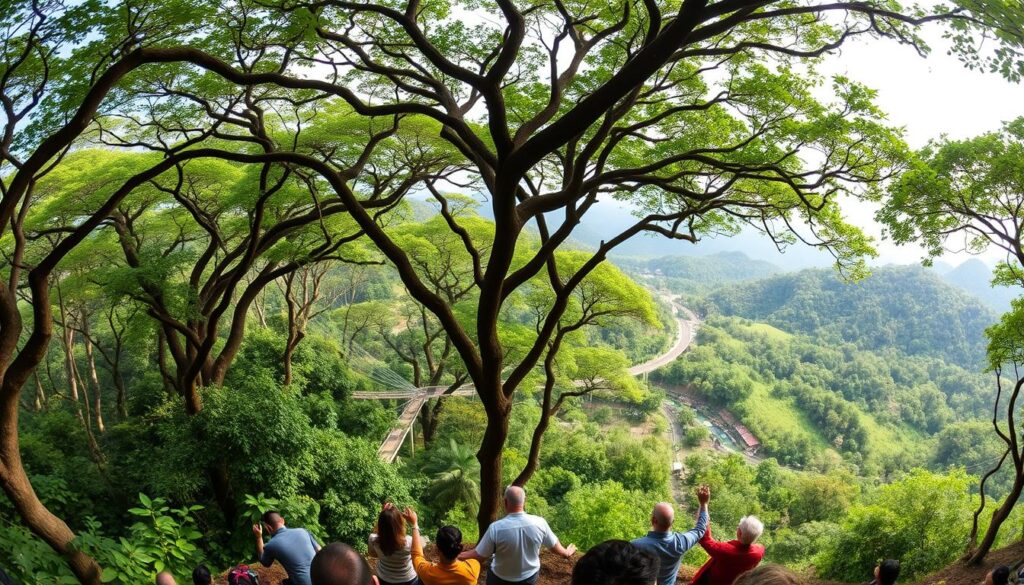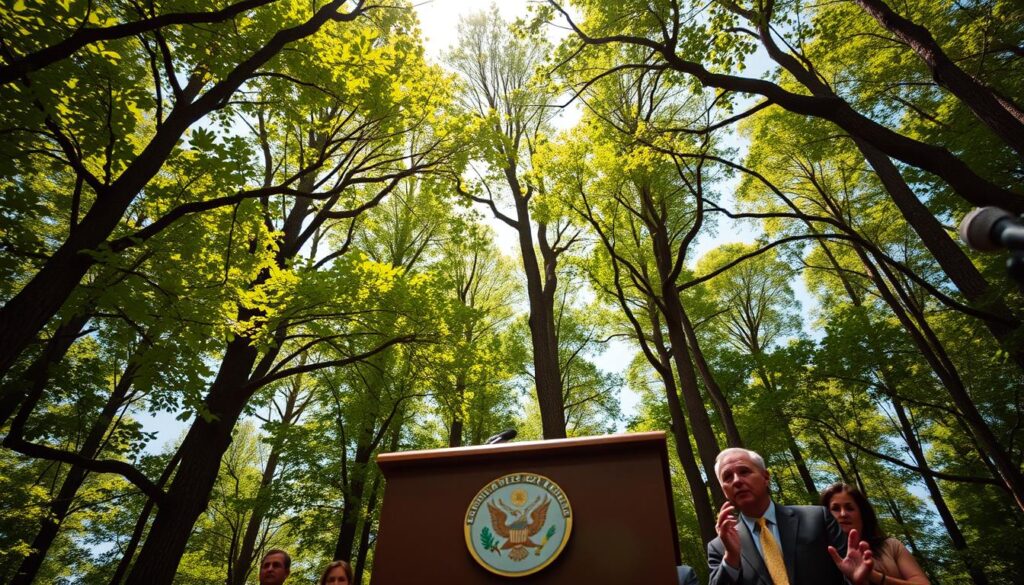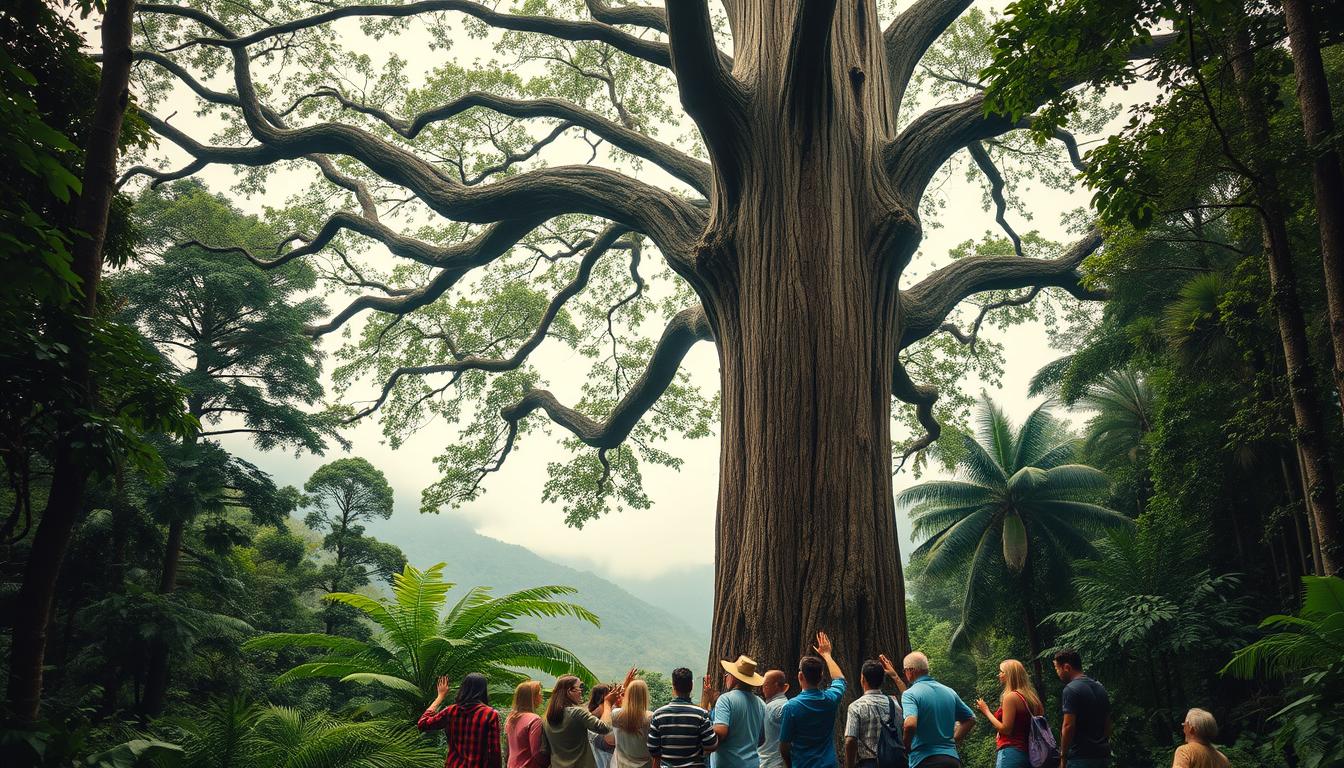The rustling leaves of ancient forests whisper an urgent plea. Every second, a forest area equal to a football field vanishes. This erases vital ecosystems that sustain our planet. As a tree saver, you stand at a critical moment where your actions can rewrite the narrative of global deforestation prevention.
Our planet is losing its green guardians at an alarming rate. Over one-third of the world’s tree species face possible extinction due to human-induced environmental changes. The consequences reach far beyond lost trees—they threaten biodiversity, climate stability, and human survival.
This isn’t just an environmental crisis; it’s a call to action. By understanding the profound impact of deforestation and embracing strategic interventions, you can become a powerful agent of change. Protecting our planet’s most critical natural resources is within your reach.
Table of Contents
Understanding the Global Deforestation Crisis
The world’s forests are disappearing fast, posing a big challenge for saving our environment. Every three seconds, an area of forest the size of a football field is lost. This threatens our planet’s balance.
Now more than ever, we need sustainable forestry to fight forest destruction. The world’s forests are changing fast, affecting biodiversity, climate, and people’s lives.
Current State of the World’s Forests
Recent data shows a harsh truth about forest loss:
- 10 million hectares of forest disappeared annually between 2015-2020
- Tropical regions experience the most significant deforestation
- Since 1990, around 420 million hectares of forest have been lost worldwide.
Impact on Biodiversity and Climate
Forests are more than just trees—they’re home to millions of species. Deforestation disrupts critical habitats, threatening many species with extinction. These ecosystems help control the climate by:
- Absorbing carbon dioxide
- Producing oxygen
- Stabilizing regional weather patterns
Economic Cost of Forest Loss
Deforestation’s economic impact is huge, affecting more than just the environment. Industries that depend on forests face big challenges, with global economic losses in the billions every year.
“Protecting our forests is not just an environmental imperative, but an economic necessity.” – Global Conservation Expert
The Critical Role of Tree Saver Initiatives
Tree saver initiatives are key in fighting global deforestation. They use new technology, community help, and careful planning to protect forests. This way, they change how we save forests.
The World Wildlife Fund (WWF) aims to restore forests. They want to:
- Restore 150 million hectares of lost forests by 2020
- Fix 350 million hectares of damaged lands by 2030
Good tree saver programs use many ways to save forests. They include:
- Working with local communities
- Using advanced satellite tracking
- Offering money to local people
- Using technology to track progress
You can help protect forests in many ways. You can support groups that save forests, choose eco-friendly products, and tell others about the importance of trees.
“Every individual action counts in preserving our planet’s forest ecosystems” – Global Conservation Network
By supporting tree saver efforts, we can all help protect our planet’s forests.
Forest Landscape Restoration (FLR) Movement
Reforestation efforts are changing how we protect our forests worldwide. The Forest Landscape Restoration (FLR) movement is key in fighting environmental damage and climate change.
Global groups are leading the way in sustainable forestry. They aim to rebuild and safeguard our planet’s forests. This effort is more than just planting trees. It’s about restoring entire landscapes to their natural state.
“Restoration is not just about trees, but about creating resilient ecosystems and supporting local communities.” – Environmental Conservation Expert
WWF’s Global Restoration Goals
The World Wildlife Fund (WWF) has set big goals for restoration. Their main goals are:
- Restore 500 million hectares of degraded landscapes by 2030
- Boost biodiversity in specific restoration areas
- Help local communities grow their economies
- Fight climate change through forest recovery
Bonn Challenge Implementation
The Bonn Challenge is a major global pledge. It aims to restore 350 million hectares of damaged landscapes by 2030. Countries are making detailed plans to use sustainable forestry.
Restoration Success Stories
Many reforestation projects have shown great results. In places like Brazil’s Atlantic Forest and African woodlands, communities are seeing real benefits. These include better environments and economic growth thanks to landscape restoration.
Your help and knowledge can aid these vital conservation efforts. Learning about forest landscape restoration is a crucial step toward making a difference.
Sustainable Forestry Practices
Sustainable forestry is key to protecting our planet’s forests and meeting human needs. It balances environmental care with using forest resources. This way, forest managers can keep forests healthy and use them wisely.
The main ideas of sustainable forestry are to keep forests healthy and diverse. Important steps include:
- Selective harvesting of mature trees
- Replanting and regeneration programs
- Protecting wildlife habitats
- Minimizing soil and ecosystem disruption
Certification systems like the Forest Stewardship Council (FSC) help a lot. They make sure logging is done right, following strict rules for the environment and people.
| Sustainable Forestry Practice | Environmental Benefit | Economic Impact |
|---|---|---|
| Selective Harvesting | Maintains Forest Structure | Reduces Wasteful Logging |
| Replantation Programs | Ensures Forest Regeneration | Long-Term Resource Sustainability |
| Wildlife Corridor Protection | Preserves Biodiversity | Supports Ecosystem Services |
Supporting sustainable forestry helps protect forests and helps local communities. It demonstrates that environmental stewardship and profitability can work together seamlessly.
“Sustainable forestry is not just about trees, but about creating a balanced ecosystem for future generations.” – Environmental Conservation Expert
Indigenous Communities and Forest Protection
Indigenous communities play a vital role in protecting our planet’s forests. They use ancient knowledge to manage forests in a sustainable way. Their connection to nature is deep and goes beyond just managing land.
These communities have a deep understanding of forests. They protect about 80% of the world’s remaining biodiversity. This shows how important they are for saving our planet.
Traditional Knowledge in Conservation
Indigenous communities have been sustainably managing forests for generations with time-tested practices. Their methods include:
- Sustainable harvesting practices
- Complex ecological monitoring systems
- Preserving the genetic diversity of plant species
- Maintaining balanced ecosystem interactions
Community-Based Forest Management
Forest management by local communities is a strong way to protect the environment. It empowers local people to care for their forests. This approach helps both the community and the planet.
| Region | Protected Forest Area | Indigenous Population Involved |
|---|---|---|
| Amazon Rainforest | 25 million hectares | 350,000 indigenous people |
| Southeast Asian Forests | 15 million hectares | 250,000 indigenous people |
| African Tropical Forests | 20 million hectares | 400,000 indigenous people |
Supporting indigenous communities is crucial for protecting our forests. Their efforts are essential for saving our planet.
Global Partnerships for Forest Conservation

Environmental conservation needs teamwork around the world. Global partnerships are key for protecting forests. They bring together governments, nonprofits, and research groups to fight deforestation.
Important international teams are changing how we save forests:
- UN REDD+ Program: Reducing emissions from deforestation and forest degradation
- New York Declaration on Forests: Voluntary global commitment to halve deforestation by 2020
- African Forest Landscape Restoration Initiative (AFR100): Aiming to restore 100 million hectares of degraded land across Africa.
The World Wildlife Fund (WWF) is a big player in these partnerships. It helps out in many global forest-saving efforts.
| Partnership | Focus Area | Primary Goal |
|---|---|---|
| Initiative 20X20 | Latin American Restoration | Restore 20 million hectares by 2020 |
| Global Partnership on Forest and Landscape Restoration | Worldwide Landscape Management | Promote sustainable land use practices |
These global teams tackle big problems by working together. They share resources, knowledge, and strategies for saving the environment. By linking people from all over, they build strong networks to protect our forests.
“Collaboration is the cornerstone of effective forest protection” – WWF Conservation Expert
Innovative Technologies in Forest Protection
Digital innovation is changing how we protect trees and prevent deforestation. New technologies give us powerful tools to watch over forests worldwide. They do this with great accuracy and success.
Today, conservation uses advanced tech to keep an eye on forest health in real-time. These systems are a big step forward in protecting our forests.
Satellite Monitoring Systems
Satellites have made a huge difference in forest protection. They help us:
- Quickly spot when forests are being cut down
- Map forest edges with precision
- Track changes in forest cover as they happen
- Find areas where logging is happening illegally
Digital Tracking Solutions
Now, digital platforms offer detailed tracking for tree-saving efforts. They give clear views into how forests are managed and protected.
| Technology | Primary Function | Impact |
|---|---|---|
| AI Forest Monitoring | Predictive Risk Assessment | 90% Accuracy in Deforestation Prediction |
| Drone Surveillance | Area Mapping | Covers Large Remote Regions |
| Geospatial Analytics | Forest Change Detection | Rapid Response Capabilities |
“Technology is our most powerful weapon in protecting the world’s forests” – Environmental Research Institute
With these new technologies, conservation teams can act quickly and well against forest threats. This is a big step forward in stopping deforestation.
Economic Incentives for Forest Preservation
Protecting our forests is more than just a wish. It needs smart economic plans that make saving forests worth it for everyone. Economic incentives are key in this fight, turning forest protection into a profitable venture.
Many new ways have shown they work well in keeping forests safe:
- Payments for Ecosystem Services (PES) programs
- REDD+ (Reducing Emissions from Deforestation and Forest Degradation) mechanisms
- Carbon credit trading systems
Costa Rica stands out as a successful model of how restoration efforts can thrive. Their PES program has cut down deforestation by paying landowners to keep their forests. This shows how money can motivate people to protect nature.
The main perks of these incentives are:
- They give financial value to saving forests
- They help local communities
- They offer new ways to make money
- They help protect nature
These creative solutions link money and nature, showing a hopeful future. You can help by learning about them and pushing for more support in forest protection.
Policy Framework and Legal Protection
Protecting our world’s forests needs strong laws and plans. Deforestation prevention needs a mix of global and local efforts.

Keeping our forests safe depends on detailed laws. Governments need to establish and uphold regulations to safeguard forests.
International Environmental Laws
Important global agreements help save forests:
- Convention on Biological Diversity
- Paris Agreement
- United Nations Framework Convention on Climate Change
“Legal frameworks are essential tools in combating global deforestation” – Environmental Policy Institute
National Forest Protection Policies
Every country has its own way to save forests. Good policies often include:
- Strict logging rules
- Rules on land use
- Support for sustainable forestry
- Penalties for illegal logging
Knowing about these laws can help us make a difference. By backing strong policies, we can save our planet’s forests.
Working together globally is the best way to stop forest loss.
Corporate Responsibility in Deforestation Prevention
Corporations are key in fighting global deforestation. Knowing about sustainable forestry and eco-friendly lumber can change how businesses protect the environment.
Today, companies are seeing their role in saving forests. They’re making big plans to lessen their harm on nature through green forestry efforts.
- Implement zero-deforestation supply chain policies
- Source certified eco-friendly lumber
- Invest in forest restoration projects
- Develop transparent tracking mechanisms
Top companies are setting big goals to cut their forest use. By focusing on green forestry, they can make a real difference and still grow their businesses.
“Our planet’s future depends on corporate accountability and environmental stewardship.” – Environmental Leadership Council
| Corporate Strategy | Environmental Impact |
|---|---|
| Certified Sustainable Wood Sourcing | Reduces forest degradation by 40% |
| Supply Chain Transparency | Eliminates illegal logging practices |
| Renewable Material Investment | Decreases pressure on natural forests |
Supporting companies that care about sustainable forestry can make a big difference. Every time you buy something, you’re choosing to support companies that act responsibly.
Individual Actions for Forest Conservation
Your choices can really help fight deforestation. Every time you buy something, you can choose to protect our forests. This helps keep our planet’s forests healthy.
Understanding your impact is the first step. Even small changes in your daily routine can have a significant impact. These changes help our environment a lot.
Sustainable Consumption Choices
Make smart choices when you shop to help forests:
- Look for products with green building materials certified by sustainable groups
- Eating less meat helps because it reduces forest clearing
- Buy recycled paper products
- Choose furniture made from wood that’s been harvested responsibly
“Individual actions, when multiplied, create global change.” – Environmental Conservation Network
Supporting Conservation Organizations
You can really help protect forests by getting involved:
- Give money to trusted groups that work to save forests
- Help out with local tree planting efforts
- Join in on campaigns to raise awareness
- Spread the word about why forests are important
Remember, your buying power is key in pushing companies to be more sustainable. It helps protect our planet’s forests.
Conclusion
Stopping deforestation is not just an environmental issue—it’s crucial for our planet’s future. Protecting our forests needs everyone’s effort, commitment, and smart actions. By becoming a tree saver, you can help save the world’s forests.
Your choices play a big role in fighting forest loss. Supporting eco-friendly brands and pushing for better environmental laws are key. Working with local and global conservation groups lets you make big differences.
Our planet’s future relies on us all working together and making smart choices. Forests are more than just trees; they’re vital for life, climate, and people. By being a tree saver, you join a global effort to protect these essential resources for future generations.
Remember what IUCN Director General Grethel Aguilar said: “Trees are the barometer of life.” Your dedication to stopping deforestation can change our world for the better. Let’s work together for a greener, healthier planet for all.
FAQ
What is deforestation and why is it a critical global issue?
Deforestation means cutting down a lot of trees, usually for farming, industry, or building. It’s a big problem worldwide because forests are key to life, climate, and many species. Each year, approximately 18.7 million acres of forests are lost, negatively impacting the climate and natural ecosystems.
How does deforestation impact climate change?
Forests help control the climate by soaking up carbon dioxide. When forests are cut down, this carbon is released, making the planet warmer. This creates a cycle that worsens climate change.
What are the most significant drivers of deforestation?
Main causes include farming for products like palm oil, soy, and cattle; logging; building; and projects like roads. Farming is the leading cause of deforestation, responsible for around 80% of forest loss.
How can individuals help prevent deforestation?
You can help by choosing products with the Forest Stewardship Council (FSC) label. Use less paper and wood, support tree planting, and pick eco-friendly items. Also, speak up for protecting forests.
What is sustainable forestry?
Sustainable forestry keeps forests healthy and productive while meeting human needs. It means picking trees carefully, replanting, and protecting animals. It also means not harming the forest too much when taking wood.
How do indigenous communities contribute to forest conservation?
Indigenous people know a lot about nature and their lands. They help protect forests by managing them in a way that keeps them healthy. This supports their way of life.
What technologies are being used to monitor and protect forests?
New tools include satellites, drones, AI, and digital tracking. They help spot illegal logging, check forest health, and give updates on conservation efforts.
What is the Bonn Challenge?
The Bonn Challenge is a plan to restore 350 million hectares of damaged forests by 2030. It’s a big effort to save forests, help biodiversity, and fight climate change.
How do economic incentives support forest conservation?
Programs like Payments for Ecosystem Services (PES) and REDD+ pay people and governments to keep forests. This makes saving forests a good choice financially.
What role do corporations play in preventing deforestation?
Companies are making promises not to cut down forests, setting rules for buying materials, and making sure their supplies are safe. This helps reduce harm to forests.

